Casper Physical Therapy Explains High School Football Injuries
October 31, 2018
Each year, there are more than a half million injuries each year on American high school football fields. Given the severity and impact of these injuries, it is best to act as soon as possible—even if signs and symptoms seem non-existent. It is a mistake many students make that can affect them throughout their life. Learn about the top types of high school football injuries, handling concussions, and using Casper physical therapy to recover.Â
Â
Given that football is a contact sport, injuries may occur. Some of the most common injuries experienced by student athletes include:
Achilles tendonitis: Swelling can occur when the Achilles tendon (back of the ankle) is strained.Â
Fractures: Contact or quick movements can lead to fractures in the hands, legs, and more.Â
Knee: Occurring from rapid twisting movements or contact, ligaments in the knee can be stretched or torn.Â
Rotator cuff: The rotator cuff is a primary support within the shoulder. When strained, it can lead to radiating arm pain.Â
Strains: Strains occur when muscles in an area have been overly stretched. They can be painful when overly extended or if they tear.Â
Sprains: Sprains arise when ligaments, which connect muscles to bones, are negatively impacted. They can be overstretched or tear.Â
Concussions are brain injuries, commonly due to an impact to the head, as well as quick, rapid movements. These rapid movements cause the brain to move around, causing issues. This movement can cause bruising or problems with crucial blood vessels. Upon receiving a blow, a student-athlete should be checked out as soon as possible. Signs of a concussion include:Â
The go-to way a student-athlete needs to recover from a concussion is to rest. Many wonder, “is it safe to sleep if you have a concussion?†If symptoms are minimal, it may be fine. It is best to go by the advice of a doctor to be certain. In extreme cases, falling asleep with a concussion can lead to a loss of consciousness.Â
For injured student football players, it is imperative to see a local physical throughout the recovery process. A premier physical therapist will ensure your student takes proper measures for a swift and successful recovery. From there, physical therapists can help the student improve their sport. This can be done by teaching various stances and techniques to avoid injuries. Students that have not sustained an injury will still benefit from training with a physical therapist to avoid getting hurt in the future. For many students, an injury can be career ending, which is unfortunate before their actual athletic career really begins.Â
If your child has sustained an injury playing football, North Platte Physical Therapy’s sports medicine team will aid in their recovery. Specializing in student-athletes, we can help with recovery as well as athletic training. This will help your student avoid injuries in the future and become a stronger, quality athlete. Contact us today to schedule an appointment.Â
Â
Read More...
Â
Most Common Types of Injuries
Given that football is a contact sport, injuries may occur. Some of the most common injuries experienced by student athletes include:
Achilles tendonitis: Swelling can occur when the Achilles tendon (back of the ankle) is strained.Â
Fractures: Contact or quick movements can lead to fractures in the hands, legs, and more.Â
Knee: Occurring from rapid twisting movements or contact, ligaments in the knee can be stretched or torn.Â
Rotator cuff: The rotator cuff is a primary support within the shoulder. When strained, it can lead to radiating arm pain.Â
Strains: Strains occur when muscles in an area have been overly stretched. They can be painful when overly extended or if they tear.Â
Sprains: Sprains arise when ligaments, which connect muscles to bones, are negatively impacted. They can be overstretched or tear.Â
Handling Concussions
Concussions are brain injuries, commonly due to an impact to the head, as well as quick, rapid movements. These rapid movements cause the brain to move around, causing issues. This movement can cause bruising or problems with crucial blood vessels. Upon receiving a blow, a student-athlete should be checked out as soon as possible. Signs of a concussion include:Â
- Blurred vision
- Brain fog
- Dizziness
- Fatigue
- Headaches
- Loss of consciousness
- Nausea
- Slurred speech
- Tinnitus
- Vomiting
The go-to way a student-athlete needs to recover from a concussion is to rest. Many wonder, “is it safe to sleep if you have a concussion?†If symptoms are minimal, it may be fine. It is best to go by the advice of a doctor to be certain. In extreme cases, falling asleep with a concussion can lead to a loss of consciousness.Â
Recovery and Physical Therapy
For injured student football players, it is imperative to see a local physical throughout the recovery process. A premier physical therapist will ensure your student takes proper measures for a swift and successful recovery. From there, physical therapists can help the student improve their sport. This can be done by teaching various stances and techniques to avoid injuries. Students that have not sustained an injury will still benefit from training with a physical therapist to avoid getting hurt in the future. For many students, an injury can be career ending, which is unfortunate before their actual athletic career really begins.Â
If your child has sustained an injury playing football, North Platte Physical Therapy’s sports medicine team will aid in their recovery. Specializing in student-athletes, we can help with recovery as well as athletic training. This will help your student avoid injuries in the future and become a stronger, quality athlete. Contact us today to schedule an appointment.Â
Â
Signs of a Stroke Explained by Physical Therapy
October 24, 2018
Each year, almost a million Americans suffer from a stroke. While a majority of that population are senior citizens, it can also happen to those that are younger. Sadly, strokes are one of the leading causes of death each year, making it crucial to detect the signs and act as soon as possible. Â Learn more about strokes and how to quickly identify the signs of one. The quicker you act for yourself or a loved one, the higher the chances are for successful treatment and recovery. Acting fast and utilizing physical therapy in Cheyenne, WY can provide a better quality of life.Â
Blood supply to the brain is vital. If blood flow to the brain becomes restricted in any way, brain cells will die, and a stroke occurs. They are most common in those with high blood pressure, as well as people that have diabetes, heart disease, a genetic history of strokes or smoke.Â
There are two types of strokes that can occur:Â
Ischemic: Most common type of stroke when the key blood vessels to the brain clot, leading to a lack of blood flow to the brain.Â
Hemorrhagic: Occurs when a blood vessel in the brain leaks or bursts.Â
To quickly identify a stroke, remember the acronym “FAST,†which stands for: Face, arm, speech, and time.Â
Seeing a local physical therapist is one of the best ways to recover from a stroke. A physical therapist will create a customized plan based on the severity of the stroke to help a person regain mobility. Top physical therapists will help a person regain crucial motor function and accomplish basic, essential tasks.Â
Whether you or a loved one has experienced a stroke, North Platte Physical Therapy is your go-to for rehabilitation and premier physical therapy. Our staff is trained and dedicated to the recovery of stroke suffers, creating a customized plan to get back to normal as much as possible. We know that each case is different and are here to help. Be sure to contact us today to set up an appointment at a North Platte location near you.Â
Read More...
What Causes a Stroke?Â
Blood supply to the brain is vital. If blood flow to the brain becomes restricted in any way, brain cells will die, and a stroke occurs. They are most common in those with high blood pressure, as well as people that have diabetes, heart disease, a genetic history of strokes or smoke.Â
There are two types of strokes that can occur:Â
Ischemic: Most common type of stroke when the key blood vessels to the brain clot, leading to a lack of blood flow to the brain.Â
Hemorrhagic: Occurs when a blood vessel in the brain leaks or bursts.Â
FAST: How to Quickly Spot a Stroke
To quickly identify a stroke, remember the acronym “FAST,†which stands for: Face, arm, speech, and time.Â
- Face: Look for changes in the face, such as numbness or dropping on one side. If unsure, as a person to smile as one side will be affected.Â
- Arm: During a stroke, one arm will become weak. Ask a person to lift their arm and look for difficulty or the inability to raise one.Â
- Speech: Slurred speech is a key sign of a stroke. Some sufferers will also mumble phrases over and over. If unsure, tell a person to say a short phrase and see if they can repeat it back to you.Â
- Time: Timing is everything. If you notice any of the following symptoms in a person, even if you aren’t sure, call 911. The faster you act, the better chances a person has at recovery and survival.Â
- Read more on these 14 signs and symptoms of a stroke to learn about additional warning sides in addition to “FAST.â€
Rehabilitation and Physical Therapy
Seeing a local physical therapist is one of the best ways to recover from a stroke. A physical therapist will create a customized plan based on the severity of the stroke to help a person regain mobility. Top physical therapists will help a person regain crucial motor function and accomplish basic, essential tasks.Â
Whether you or a loved one has experienced a stroke, North Platte Physical Therapy is your go-to for rehabilitation and premier physical therapy. Our staff is trained and dedicated to the recovery of stroke suffers, creating a customized plan to get back to normal as much as possible. We know that each case is different and are here to help. Be sure to contact us today to set up an appointment at a North Platte location near you.Â
What Your Physical Therapist Has to Say About Keeping Knee Injuries From Occurring
October 17, 2018
If you’re an athlete—either someone who competes or just a weekend warrior—chances are pretty good that you have experienced some kind of knee issue. In fact, knee injuries are one of the most common reasons people seek out treatment such as physical therapy. Not only do knee injuries hurt, but they can prevent you from participating in the sports you love—and they can make life difficult in general. Before your healthy knees become unhealthy knees, read on to find out what a Cheyenne, WY physical therapist has to say about how you can protect your knees from injury.
At North Platte Physical Therapy, we want our patients to have healthy knees and live a pain-free life. If you have suffered an injury, we invite you to contact North Platte Physical Therapy to learn more about how we can help you recover. Our staff is well known throughout Wyoming because of our strong commitment to our patients. We can fulfill comprehensive physical therapy services, and we look forward to creating a custom a treatment plan based on your needs. Contact us today!
Â
Read More...
Maintain a Healthy Weight
Even just the stress of walking can harm your knees if you are carrying around extra pounds. Then if you had sports into the mix, you are really adding to the burden your knees must handle. Keep your weight at an appropriate level for your height to keep your knees from being unduly stressed.Find Low-Impact Activities
If you are carrying around a few extra pounds that you want to lose, or if your knees have a tendency to be tender, sticking to low-impact activities can really help the impact on your knees while still keeping you active. If you are looking for cardio options, there are plenty of machines at the gym, such as the elliptical, that can give your heart a good workout and keep your knees protected.Warm Up Before and Stretch After Each Work Out
Both of these are easy to skip when you are eager to get started competing or working out, but both are important to your routine. Warming up will loosen up muscles and tendons, making you less prone to injury. Stretching after your workout will help with mobility, and also help to protect you from injury.Wear Good Quality Shoes
If you are on your feet a lot—whether for sports or for everyday life—wear the right shoes for the job. If you stand a lot for your job, the proper footwear can protect your knees as well as your back. They can also keep you more comfortable all day. If you are into a sport such as running, go to a professional running store so they can recommend the proper shoe. This article has good information on appropriate shoes for both walking and running: 10 Best Walking and Running Shoes for Bad Knees and OA Knee Pain.Strength Train
Strength training—as long as you are using proper form—can strengthen the muscles and tendons in your legs, making less prone to injury. Have a coach or personal trainer give you training on proper form as this is essential to prevent injuries.ÂSeek Physical Therapy When Needed
Sometimes injuries and strains happen, and when they do, don’t hesitate to seek out the help of a physical therapist to help you get past the pain. You can find out more about seeing a physical therapist and learning what to expect by reading here.At North Platte Physical Therapy, we want our patients to have healthy knees and live a pain-free life. If you have suffered an injury, we invite you to contact North Platte Physical Therapy to learn more about how we can help you recover. Our staff is well known throughout Wyoming because of our strong commitment to our patients. We can fulfill comprehensive physical therapy services, and we look forward to creating a custom a treatment plan based on your needs. Contact us today!
Â
When to Use Ice Versus Heat for Injuries
October 10, 2018
When you are hurting from a muscle strain or an injury, you might be wondering if you should treat your pain with ice or heat. Treating chronic pain with either can be highly effective, but it’s crucial to know which situations call for which treatment—and which call for both. Take the advice of a physical therapist to ensure you are using them effectively.
Let’s take a look at when you should be using ice versus heat.
There is also heat from an ultrasound, which can be highly effective. Sitting in a sauna is another option.
Heat therapy can soothe muscles and damaged tissue because it increases blood flow and temperature in the area, which promotes healing. Be sure you are using warm heat rather than hot.
Be sure you do not use heat therapy for the following:
You can purchase ice packs at the drugstore, which you keep in the freezer to use when needed. They come in all different kinds of shapes and sizes.
There are also coolant sprays available. Ice baths are another option that athletes often use to reduce potential swelling after a particularly tough workout.
Don’t use cold therapy if you have sensory disorders or poor circulation.
Never apply a cold pack directly to the skin; wrap it first in a towel or cloth or it can damage the skin and tissues.
Cold therapy is most effective when it is used several times throughout the day for 10 to 15 minutes at a time, applied to the affected area.
If you need more information about treating pain or injuries with ice or heat, give us a call today. North Platte is your go-to local physical therapist in Douglas, WY to provide the services that will get you feeling better and stronger. Our expert staff is respected throughout the Wyoming and Nebraska areas for providing superior and customized physical therapy services. We can handle any of your physical therapy needs. Fill out our contact form to get started and to find a location near you.
Â
Read More...
Let’s take a look at when you should be using ice versus heat.
Use Heat for Muscle Pain or Stiffness
There are two different types of heat you can use for muscle pain or stiffness: dry heat and moist heat. If you have ever used a heating pad, then you know how easy it is to apply dry heat. Moist heat can come from a source such as a steaming towel or a hot bath.There is also heat from an ultrasound, which can be highly effective. Sitting in a sauna is another option.
Heat therapy can soothe muscles and damaged tissue because it increases blood flow and temperature in the area, which promotes healing. Be sure you are using warm heat rather than hot.
Be sure you do not use heat therapy for the following:
- There is a bruise or burn in the affected area.
- There is a pre-existing condition such as diabetes, dermatitis, multiple sclerosis, or vascular disease that can be negatively affected by the heat.
- If you are pregnant, use of a hot tub or sauna for heat therapy is not recommended.
Use Ice for Injuries, Pain, Inflammation, and Swelling
Cold therapy does the opposite of heat therapy in that it draws blood flow away from the affected area. This can help reduce swelling and inflammation. It also numbs the area, temporarily relieving pain.You can purchase ice packs at the drugstore, which you keep in the freezer to use when needed. They come in all different kinds of shapes and sizes.
There are also coolant sprays available. Ice baths are another option that athletes often use to reduce potential swelling after a particularly tough workout.
Don’t use cold therapy if you have sensory disorders or poor circulation.
Never apply a cold pack directly to the skin; wrap it first in a towel or cloth or it can damage the skin and tissues.
Cold therapy is most effective when it is used several times throughout the day for 10 to 15 minutes at a time, applied to the affected area.
If you need more information about treating pain or injuries with ice or heat, give us a call today. North Platte is your go-to local physical therapist in Douglas, WY to provide the services that will get you feeling better and stronger. Our expert staff is respected throughout the Wyoming and Nebraska areas for providing superior and customized physical therapy services. We can handle any of your physical therapy needs. Fill out our contact form to get started and to find a location near you.
Â
Casper Physical Therapy Tips to Combat Sedentary Lifestyles
October 3, 2018
If you have a desk job and a commute into work every day, you are like many people who spend too much time sitting all day. Some experts are calling this the “new smoking†because it is having such a detrimental impact on our overall health—similar to the negative effects of smoking cigarettes. A lot of people are even suffering from chronic pain because of this unhealthy way of life. There are things you can do, however, and here are some tips from a Casper physical therapy expert.
If you can incorporate the above tips into your life, you will be well on your way to staying in motion, which is crucial for your overall wellbeing.
Contact North Platte Physical Therapy to learn more about the effects a sedentary lifestyle can have on your body. Our staff is admired throughout the Wyoming and Nebraska areas because of our commitment to our clients. We can fulfill comprehensive physical therapy services, and we are happy to customize a treatment plan that can help you go to your job every day without serious health ramifications. Give us a call!
Â
Read More...
Take Frequent Walking Breaks
It’s easy to sit at your desk hour after hour without getting up, but frequent walking breaks is good for your health. Instead of instant messaging someone in your office, get up and walk to speak face-to-face. If you forget to get up, get one of the popular fitness trackers on the market and set up reminders to get up for a few minutes every hour or so. (These trackers can also help make sure you get a minimum number of steps in each day.)Take the Stairs
If you have the opportunity to choose the stairs or an elevator, always take the stairs. Stair-climbing burns a lot of calories—and it is good for your heart.Stand Up When You Can
When you are a phone call stand up and walk around, if possible. Or ask your company to invest in a standing desk for you. Most of them are affordable and adjustable so you can move back and forth between sitting and standing.Drink Plenty of Water
Staying hydrated is good for your body—and it will mean more frequent trips to the restroom, which will get you moving more. If you are wondering just how much water is enough, take a look at this article: How Much Water Should You Drink Each Day?Park Far Away
Don’t look for the closest parking spot; find one that will force you to walk a bit farther—whether you are at the office or the mall. This is a good way to incorporate more walking into your day.Hit the Gym or the Trail
If you aren’t already working out, make it a part of your normal routine. You don’t need to spend hours each day at the gym or run 10 miles at a time to benefit. Even just 20 minutes a day will go a long way toward improving your health.If you can incorporate the above tips into your life, you will be well on your way to staying in motion, which is crucial for your overall wellbeing.
Contact North Platte Physical Therapy to learn more about the effects a sedentary lifestyle can have on your body. Our staff is admired throughout the Wyoming and Nebraska areas because of our commitment to our clients. We can fulfill comprehensive physical therapy services, and we are happy to customize a treatment plan that can help you go to your job every day without serious health ramifications. Give us a call!
Â




